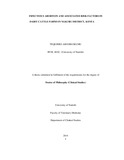| dc.description.abstract | Agriculture plays a significant role in the Kenyan economy. According to
estimates, 15% of the total farm revenue in Kenya is generated from livestock products,
of which 3.5% is from the dairy sector. Several factors, however, hamper productivity of
the sector. These include feeds, husbandry, marketing and animal diseases among others.
Reproductive diseases limit the dairy industry from achieving optimum efficiency. Some
of the diseases that cause major reproductive wastage, including abortion, in the dairy
industry in many parts of the world include leptospirosis, campylobacteriosis, bovine
viral diarrhoea, brucellosis and neosporosis.
Typically, the diagnostic rate for cases of abortion in the livestock sector is low.
In Kenya, Leptospirosis, Campylobacteriosis and Brucellosis have been confirmed as
causes of abortion in dairy cattle. However, there is a paucity of information on other
pathogens such as Bovine viral diarrhoea virus (BVDV) and Neospora caninum (NC),
and their interrelationships as causes of abortion, yet these have a major role on
reproductive wastage globally. Additionally, there is no comprehensive study that has
been carried out on the causes of abortion in Kenyan dairy cattle herds.
This study was therefore designed to investigate the infectious causes of abortion
and associated risk factors in dairy cattle in Nakuru District, a major dairying area in
Kenya. Across-sectional study was carried out to determine: 1) management practices in
dairy cattle farms in Nakuru; 2) prevalence of antibodies against Bovine Viral diarrhoea
Virus (BVDV), Brucella abortus (BA) and Neospora caninum (NC) in cattle; and 3)
XVI
prevalence of NC in farm dogs in the selected farms. A prospective epidemiological
study was then undertaken to investigate the effects of BVDV, BA and NC on the
occurrence of bovine abortion in the dairy cattle herds. A questionnaire was also
administered to animal health service providers in Nakuru District to determine their
knowledge, attitude and practices on bovine abortion.
In the 398 tested cattle on the 64 dairy herds, the prevalence of antibodies to
BVDV, NC and BA was 79.1, 25.6 and 16.8%, respectively. Of the cattle seropositive to
NC, 83.3% were also seropositive to BVDV (OR =1.4) and 13.7% to BA (OR = 0.7). Of
the cattle seropositive to BVDV, 17.1% were also seropositive to BA (OR = 1.1). The
seroprevalence of NC in 84 tested farm dogs on 53 dairy farms was 17.9%, and lack of
confinement was associated with its occurrence (OR =4.5, P<0.05).
The prospective study revealed reproductive wastage in 260 monitored pregnant
dairy cattle on the 64 dairy farms, with an incidence of 11.1% (28/260) for abortion,
while the incidence of other foetal losses was 1.1% (3/260) The incidence rates of the
NC, BVD and BA in this study was 1.1, 0.06 and 0.5 new infections/100 cow months at
risk respectively. The foetal losses were observed in animals less than 96 months old, and
occurred in mid-gestation. Neospora caninum was associated with most cases (29.0%) of
foetal losses, followed by mixed infections of NC and BVDV (12.9%), BVDV (9.9%)
and co-infections of BA and NC (6.5%). Age of the dam was the only factor significantly
associated (negatively) with foetal loss in the present study (p<0.05).
XVII
The factors that animal health service providers considered associated with the
occurrence of dairy cattle abortion were: infections (77.2%), malnutrition (40.9%),
inclement weather (37.8%) and intoxication (4.5%). The infectious diseases that they
considered associated with the occurrence of bovine abortion were: brucellosis (92.4%),
Rift Valley fever (43.9%), leptospirosis (27.3%), toxoplasmosis (9.1%), infectious bovine
rhinotracheitis (6.0%), trichomoniasis (4.5%), bovine viral diarrhoea virus (3.0 %),
fungal and yeast infections (3.0%) and neosporosis (1.5%).
The present study confirmed the occurrence of all three abortifacient pathogens in
the study area, and it is the first study to document the presence of NC in dairy cattle in
Kenya. Although animal health providers perceived BA to be the pathogen most likely to
be the cause of bovine abortion, BVDV was the abortifacient agent found to have the
highest antibody prevalence, and NC was the pathogen most associated with cases of
abortion in the present study. The high prevalence of BVDV and the high frequency of
abortions associated with NC seropositivity may have been due to the lack of adequate
control measures such as vaccination, screening and isolation of new introductions and
improved biosecurity for these two diseases; this was probably due to lack of awareness
of the presence of the conditions in dairy cattle in Kenya and consequently low levels of
knowledge by the animal health industry players on the impact of these diseases.
The knowledge of the animal health providers needs to be updated through
training to make them aware of the disease trends in their areas of practice since they are
in the frontline of disease control measures. In addition, a policy on the control of
XVIII
abortifacient pathogens should be developed in order to reduce the losses associated with
these infections. | en_US |

